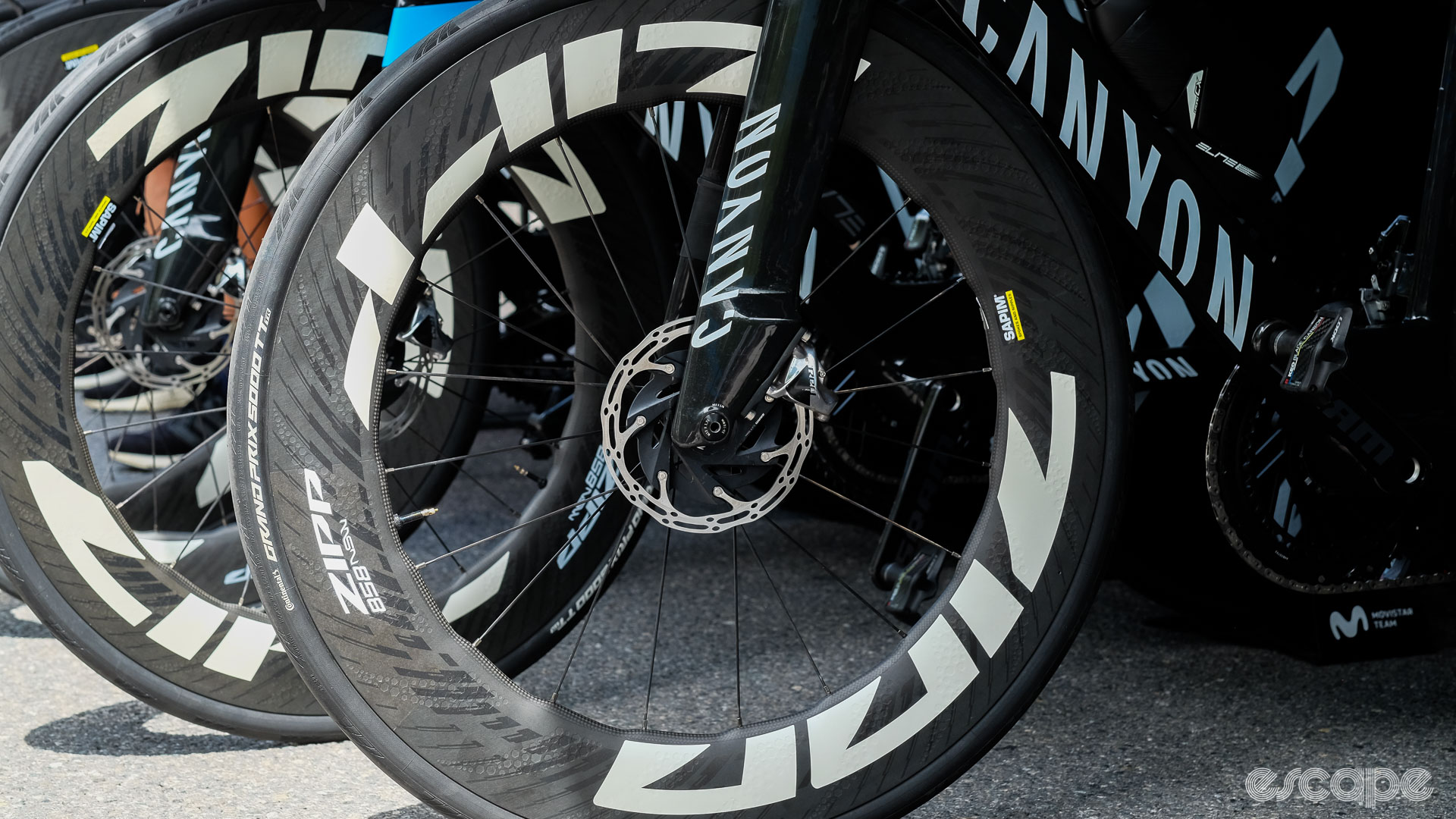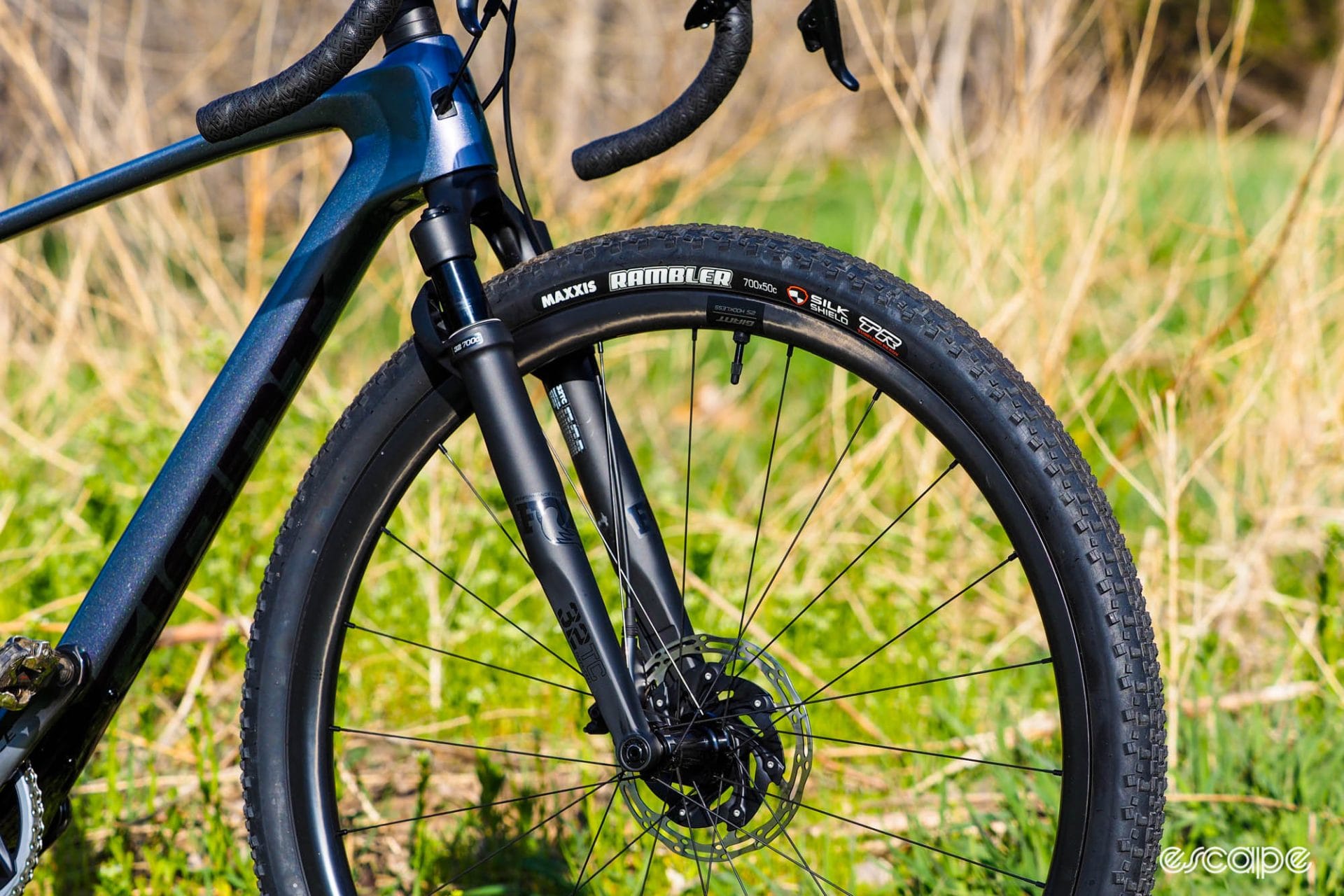Why in 2023, when aero is everywhere, are the deepest and presumably most aerodynamic wheels all but disappearing from the pro peloton? It's not long ago that Zipp 808s were king for flat stages; heck, there once was a 1080 front and rear option. Fast forward to today, everything is aero, but save for the Victor Campenaerts of this world, the deep wheel seems like an endangered species.
That question floated around our internal "Geek Stuff" Slack channel during stage 11 of this year's Tour de France. Admittedly, with 1800+ meters of elevation gain that day, it wasn't exactly flat, but there were other stages with much less climbing, not to mention all the perfectly flat races we see elsewhere on the calendar, and yet we rarely see anything more than a 60 mm-deep rim. Surely, the aero gain from a deeper rim is even more at home on the already aero bikes in the modern peloton? Or do two aeros make a wrong?
We asked a few industry and WorldTour insiders for their opinion. Unfortunately, there's no simple answer; there isn't even a consensus, but a host of potential reasons why the deep wheel has fallen out of favour with riders, teams, and brands.
Common knowledge suggests deeper wheels are faster wheels, hence why the 80, 90, and 100 mm-deep rims still rule on time trial day. Everyone we spoke to confirmed as much, but the decision to ditch aero wheels for road stages seems much more nuanced and most due to the diminishing returns of deeper rims combined with the trade-offs in tyre integration, weight, and handling.
Tyre Width
Ah tyres, is there a better place to start? Probably, but anyway ... some of those we spoke to suggest the 80mm deep rims have fallen behind as the peloton trends toward wider tyres. As almost every rider and team is now using 28 mm or wider tyres, modern rims are trending wider to match. The "Rule of 105" was discovered and coined by Silca's Josh Poertner during his days at Zipp and states that the rim must be at least 105% the width of the tyre in order to re-attach the airflow from the tyre. In other words, the aero rim can't do its job in smoothing out the airflow if it is hiding behind a wider tyre. When the rim is wider than the tyre, roughly to the tune of 105%, it can capture the turbulent airflow coming off the tyre and smooth it out across the nice, smooth aero rim profile. Turbulent air = slow; smooth airflow = fast.
Most deeper wheels are either from the 25 mm tyre era, and as such, feature narrower external rims widths, or feature narrower rims to help keep the weight down. Either way, the narrow rims are too narrow for today's wider tyres if you are to adhere to the rule of 105. Of course, aerodynamics are only one piece of the wheel-drag puzzle, the other being rolling resistance. Most teams now want to reduce rolling resistance with a wider tyre and reduce aero drag with the optimal rim width. The narrower but deeper rims tend to only tick one of these boxes and as such have fallen out of favour as riders opt for the wider, lighter, and almost as aero rims around 60 mm deep.
That said, Dov Tate of Parcours suggests as riders move to wider and wider tyres, deeper rims have a much better chance of circumventing the side effects of not complying to the rule of 105. As Tate explains, "The impact of a tyre that is too wide for the rim is lessened with a deeper rim," continuing, "A deeper rim gets much closer to what we see as the ideal 4:1 width depth ratio of a NACA airfoil profile, meaning the rim can still aid in reattaching the airflow."

Weight & Inertia
Ok, so why not just make a 100 mm-deep rim with a 30 mm external rim width? The answer, put simply, is likely down to weight.
As Tate also explained, the biggest aero gain is in changing the entire rim profile rather than just the depth. After ditching the old box-section 32-spoke wheels, you'll get more in going from a narrow aero rim to a modern wide rim than you are likely to realise in moving from a wide 60 mm to a wide 80 mm.

That said, while the aero gains may be small, the weight penalty will likely be more significant. The Parcours Chrono is a favoured aero wheelset of mine and features a 68.6 mm-deep front paired with a 75.7 mm rear. Those depths are matched with a 32 mm external rim width up front and a 30.5 at the rear. This asymmetrical (front to rear) rim design was developed as part of the Parcours "Think Wider" program designed around a 28 mm tyre and said to offer improved aerodynamics and crosswind stability for such a deep wheelset. The wheelset does weigh 1,620 grams, though, and presumably, this weight would be even higher for a modern 80+ mm-deep rim.
It is this weight that others point to as an explanation for the demise of deeper wheel offerings. Be it linked to the disc brake takeover or increased focus on aero and integration, bikes these days are already heavier. It seems the peloton has decided the aero gains in going from a 60 to an 80 mm rim do not justify making a heavier bike even heavier.
But it isn't just total bike weight. Riders and teams both told us they did not like the increased rim weight, especially when accelerating. That's something backed up by Tate, who explained the rotational inertia from deeper-but-heavier rims results in lower acceleration and deceleration, something Tate explains is an issue on technical stop-start courses and when accelerating in a bunch sprint.
A lightweight mega-deep rim is not impossible. Zipp has the new 858 NSW, at 82/85 mm deep and weighing in at claimed 1,530 grams for a complete wheelset. There is always some trade-off, though, and followers of the Rule of 105 and modern tyre trends may well be disappointed with the 858 NSW's 27 mm external rim width.

If anyone looks like pulling off the mega deep and wide rim in a lightweight wheel, it is Syncros, who unveiled a 1,307-gram, 60 mm-deep wheelset in the Capital SL Aero just last week.
While such a wheel may well be possible, the response from Syncros suggests it might be best we don't hold our breath. "At the beginning of development, Team DSM-Firmenich were asking for an 80mm front wheel," William Juban, Head of Engineering at Syncros explains, "however as our product development continued, we found the 60mm to be the optimal size." According to Juban, the Capital Aero SL front wheel has produced results as fast as a regular-spoked 80mm rim, but with better stability, less sensitivity to crosswinds, plus a weight comparable to that of a 40 mm rim.
Still not convinced I don't want an 80 mm or deeper rim, I asked Syncros what the aero gain was in moving from their new 40 mm Capital SL to the 60 mm deep Capital SL Aero. Syncros suggests the aero gains from 40 to 60 mm were "approximately 3.5 watts. However, variables between the two wheels mean this is not exactly a like-for-like comparison."
Control
The increased crosswind sensitivity and handling compromises are the final (or the first for some) 80 mm barrier for many riders. While almost everyone will go to at least 80 mm and sometimes deeper on their time trial bikes, most prefer the 60 or 50 mm offerings for mass-start races.
The deeper the rim, the greater the crosswind sensitivity, regardless of how modern, wide, U-shaped, or whale-inspired the design is. For this reason, many riders are less inclined to choose deeper rims, and rightly so. Better yet, as Tate explains, modern rims are outperforming their depth when compared to previous generation designs. Tate points to Parcours' new Strada 49/54 wheelset, which he claims "performs aerodynamically like an older 60 mm rim but handles like a 40."
Faster and more stable, sounds great, so why not go all in and create an 80 mm that performs aerodynamically like a 100 mm rim and handles like a 60? Tate again points to the diminishing returns and unavoidable drawbacks in terms of handling and weight. I also suspect the decision is no small part down to demand.

As mentioned earlier, many riders simply do not like the handling characteristics of much deeper rims, and thus opt for shallower or, at most, mid-depth wheels. Furthermore, with the pros no longer using said deep rims, it is easy to imagine brands simply cannot justify dedicating all the R&D expenditure etc, to creating a modern wheelset the market demand simply does not support. Whether we ever see more widespread use of the 80+ mm rims again seems unlikely, but probably hinges on a rather chicken or egg-type situation. The brands seemingly don't care much for making modern, mega deep, wide, and light rims while the pros aren't using them, but at least some of the pros aren't using them because they don't have access to modern, mega-deep, wide, and light rims. All the while, with the pros not using such wheels and the brands not developing them, the market isn't demanding them ... except myself and one highly successful pro who said something along the lines of - F*#k yeah, love deep wheels, give me 120s, I'll take 'em.
Did we do a good job with this story?



